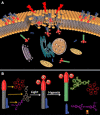Cell membranes targeted unimolecular prodrug for programmatic photodynamic-chemo therapy
- PMID: 33537100
- PMCID: PMC7847693
- DOI: 10.7150/thno.55014
Cell membranes targeted unimolecular prodrug for programmatic photodynamic-chemo therapy
Abstract
Photodynamic therapy (PDT) has emerged as one of the most up-and-coming non-invasive therapeutic modalities for cancer therapy in rencent years. However, its therapeutic effect was still hampered by the short life span, limited diffusion distance and ineluctable depletion of singlet oxygen (1O2), as well as the hypoxic microenvironment in the tumor tissue. Such problems have limited the application of PDT and appropriate solutions are highly demand. Methods: Herein, a programmatic treatment strategy is proposed for the development of a smart molecular prodrug (D-bpy), which comprise a two-photon photosensitizer and a hypoxia-activated chemotherapeutic prodrug. A rhodamine dye was designed to connect them and track the drug release by the fluorescent signal generated through azo bond cleavage. Results: The prodrug (D-bpy) can stay on the cell membrane and enrich at the tumor site. Upon light irradiation, the therapeutic effect was enhanced by a stepwise treatment: (i) direct generation of 1O2 on the cell membrane induced membrane destruction and promoted the D-bpy uptake; (ii) deep tumor hypoxia caused by two-photon PDT process further triggered the activation of the chemotherapy prodrug. Both in vitro and in vivo experiments, D-bpy have exhabited excellent tumor treatment effect. Conclusion: The innovative programmatic treatment strategy provides new strategy for the design of follow-up anticancer drugs.
Keywords: cell membrane; combination therapy; glutathione; singlet oxygen; two-photon photodynamic therapy.
© The author(s).
Conflict of interest statement
Competing Interests: The authors have declared that no competing interest exists.
Figures






Similar articles
-
Hypoxia and Singlet Oxygen Dual-Responsive Micelles for Photodynamic and Chemotherapy Therapy Featured with Enhanced Cellular Uptake and Triggered Cargo Delivery.Int J Nanomedicine. 2024 Jan 12;19:247-261. doi: 10.2147/IJN.S432407. eCollection 2024. Int J Nanomedicine. 2024. PMID: 38229704 Free PMC article.
-
Supramolecular micelles as multifunctional theranostic agents for synergistic photodynamic therapy and hypoxia-activated chemotherapy.Acta Biomater. 2021 Sep 1;131:483-492. doi: 10.1016/j.actbio.2021.07.014. Epub 2021 Jul 13. Acta Biomater. 2021. PMID: 34265471
-
pH and singlet oxygen dual-responsive GEM prodrug micelles for efficient combination therapy of chemotherapy and photodynamic therapy.J Mater Chem B. 2020 Jul 14;8(26):5645-5654. doi: 10.1039/d0tb00622j. Epub 2020 Jun 15. J Mater Chem B. 2020. PMID: 32538389
-
Recent advances in innovative strategies for enhanced cancer photodynamic therapy.Theranostics. 2021 Jan 15;11(7):3278-3300. doi: 10.7150/thno.54227. eCollection 2021. Theranostics. 2021. PMID: 33537087 Free PMC article. Review.
-
Strategic Design of Conquering Hypoxia in Tumor for Advanced Photodynamic Therapy.Adv Healthc Mater. 2023 Sep;12(24):e2300530. doi: 10.1002/adhm.202300530. Epub 2023 May 10. Adv Healthc Mater. 2023. PMID: 37186515 Review.
Cited by
-
Lipid Specific Membrane Interaction of Aptamers and Cytotoxicity.Membranes (Basel). 2021 Dec 27;12(1):37. doi: 10.3390/membranes12010037. Membranes (Basel). 2021. PMID: 35054563 Free PMC article.
-
Hyperbranched Polymers: Recent Advances in Photodynamic Therapy against Cancer.Pharmaceutics. 2023 Aug 28;15(9):2222. doi: 10.3390/pharmaceutics15092222. Pharmaceutics. 2023. PMID: 37765191 Free PMC article. Review.
-
Development of a hypoxia-activated red-emission fluorescent probe for in vivo tumor microenvironment imaging and anti-tumor therapy.Mikrochim Acta. 2024 Mar 23;191(4):217. doi: 10.1007/s00604-024-06291-7. Mikrochim Acta. 2024. PMID: 38519619
References
-
- Wilson BC, Patterson MS. The physics, biophysics and technology of photodynamic therapy. Phys Med Biol. 2008;53:R61. - PubMed
-
- Luby BM, Walsh CD, Zheng G. Advanced photosensitizer activation strategies for smarter photodynamic therapy beacons. Angew Chem Int Ed Engl. 2019;58:2558–2569. - PubMed
-
- Zheng DW, Li B, Li CX, Fan JX, Lei Q, Li C. et al. Carbon-dot-decorated carbon nitride nanoparticles for enhanced photodynamic therapy against hypoxic tumor via water splitting. ACS Nano. 2016;10:8715–8722. - PubMed
-
- Ouédraogo GD, Redmond RW. Secondary reactive oxygen species extend the range of photosensitization effects in cells: DNA damage produced via initial membrane photosensitization. Photochem Photobiol. 2003;77:192–203. - PubMed
-
- Redmond RW, Kochevar IE. Symposium-in-print: Singlet oxygen invited review. Photochem Photobiol. 2006;82:1178–1186. - PubMed
Publication types
MeSH terms
Substances
LinkOut - more resources
Full Text Sources
Other Literature Sources

